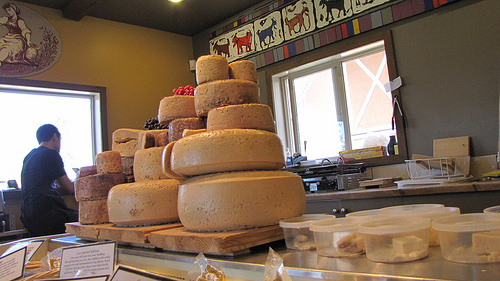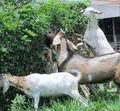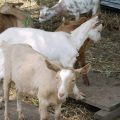Jubilee cheese is a fresh soft cheese with a spicy flavor characterized by brown specks of nutmeg on its surface and body. It is made from goat’s milk by salting, pasteurizing, and coagulating with IFS-6 milk coagulant before cutting, draining, and addition of nutmeg powder, knitting, blocking and packaging.

Jubilee Cheese from Goat’s Milk
Materials:
5 liters goat’s milk
125 gms. salt
30 cc DTRI-IFS-6 (milk coagulant)
1 gm. nutmeg powder
Utensils used:
5-liter saucepan
Scoop or dipper, kitchen knife, ladle
Basin, thermometer, cheesecloth
Perforated plastic tray or any desired mold
Banana leaves or plastic sheets
Nylon cloth as strainer
Stove
Procedure:
1. Strain the milk through a nylon cloth, pour into a sauce pan. Add salt and stir well until completely dissolved. Then, heat it over a low flame to 75oC, stirring slowly. At this temperature, steam or vapor may be seen rising from the milk surface when the milk is about to simmer.
2. Immediately cool milk to 38oC by placing saucepan in a basin of cold or tap water. Add the milk coagulant, and stir the milk for one minute. Cover and leave the milk undisturbed for 30 to 40 minutes. With a kitchen knife, cut the coagulated milk or coagulum into one-inch cubes. Without disturbing the curd, remove the free whey by means of a scoop or dipper.
3. Gently stir the curd now and then to enhance separation of the whey, and continue to remove the free whey until it amounts to 2.5 liters. Mix one gram of nutmeg powder with the partially drained curd. Scoop the spiced curd into a perforated tray lined with a cheesecloth. Level curd thickness. Cover curd with cheesecloth and allow whey to
drain for one hour.
4. Cut the knitted curd into pieces of desired size, and serve. The cheese may be wrapped in plastic streets or banana leaves and stored in the refrigerator overnight before serving. Jubilee cheese may be served on top of a lettuce leaf garnished with slices of tomato or peach.
5. One to 1.3 kilograms of Jubilee cheese can be produced from five liters of goat’s milk.
Source: dost.gov.ph, redb.uplb.edu.ph






